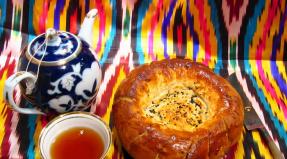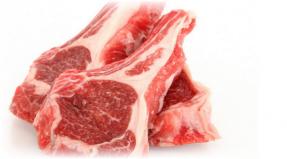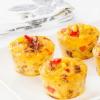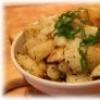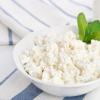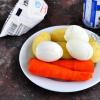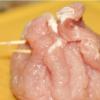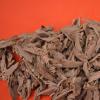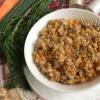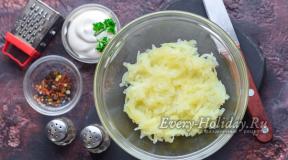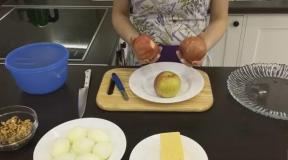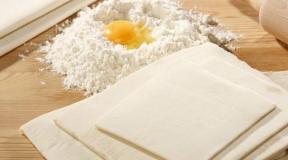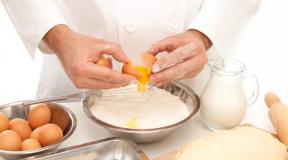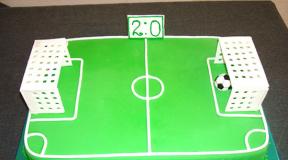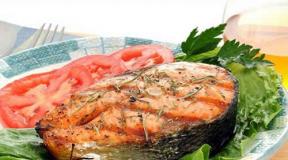Features of curd paste - sweet preparation. Curd mass at home What is curd paste
Curd spreads
Among the sweet dishes of Russian cuisine, a very special place is occupied by cottage cheese pastes, which bear the old name - Easter. The largest number of Easter options was developed at the end of the 18th-19th centuries, and it appeared primarily at a rich table. Ordinary people could afford such an expensive dish for that time extremely rarely, almost once a year, timed to coincide with a big church holiday, and even by the time milk appeared. In fact, curd pastes have nothing to do with religious rituals, and are currently made everywhere all year round. There are two types of curd pastes - raw and custard, or heated, there is also an intermediate type - the so-called pastry pastes. They are all similar in composition to the main products, but each type differs in its technology.
The main products in pastes are cottage cheese, butter, sour cream, cream, sugar, eggs; additional - nuts, candied fruits, raisins and various spices (most often vanilla and lemon zest). Cottage cheese and sugar are present in all pastas. Cream, sour cream and butter are not always found at the same time, and eggs are used even less often - either whole, then one yolk, then separately proteins.
The technology of raw pasta is outwardly simple, it consists in mechanical mixing of all the ingredients mentioned in the recipe. However, a strict sequence has been established in which the products are mixed, and, in addition, mixing or grinding is carried out very carefully and for a long time, in some cases within an hour.
To obtain a custard paste, the products are mixed and then boiled over very low heat for 1 hour, and some of the products are sometimes added later in raw form.
Pastes are called confectionery if only cottage cheese is cooked, and all other products are mixed raw. Confectionery also includes raw pasta, then baked in the oven, like flour products. After production, confectionery pastes are not pressed like raw and custard pastes.
In general, it must be said that during the pressing of raw pasta, part of the nutrients is lost, therefore, from the point of view of rational use of products, it is better to do without pressing.
On the contrary, custard paste must be compressed (due to the release of whey).
Rules for the preparation of raw pasta.
1.
When choosing cottage cheese, give preference to non-granular homemade cottage cheese, prepared in a cold way, and from purchased ones - low-fat cottage cheese, which has a very weak granularity.
2.
To grind all products not together, but in parts - either completely separately from each other, or in a certain sequence.
3.
First, grind the cottage cheese. Add some powdered sugar to it, then add butter and sour cream. Grind the main part of sugar with eggs, most often separately with yolks, white.
4.
Add the egg-sugar mixture to the butter-curd mixture and grind together, despite the fact that each of them has already been grinded separately.
5.
The third tab is powdered spices mixed with a small amount of powdered sugar.
6.
The last to add to the paste is whipped cream or whipped whites, and sometimes both.
7.
The final stage is the introduction of raisins, candied fruits, nuts into the paste. In this case, the paste is not rubbed, but only slightly mixed so that the raisins and other components are evenly distributed throughout the mass.
Raw pasta
Rules for the preparation of custard pastes.
1.
Mix all components according to the scheme indicated for raw pastes. Each specific recipe indicates which products are to be mixed (sometimes some of the products - sugar, butter, spices and even a certain proportion of cottage cheese - are added additionally to the almost finished paste at a later stage).
2.
Put the resulting mixture in a saucepan over low heat and, stirring continuously, cook for 1 hour.
3.
Then add the products specified in the recipe to the mass, stir again, cool (sometimes put on ice), wrap in a clean linen napkin, it is best to wash it several times (that is, less dense), put it under a press between two wooden planks or in a special wooden form-box and soak from 12 hours to 2 days.
... V.V. Pokhlebkin. 2005.
See what "Curd Pastes" is in other dictionaries:
THE SECRETS OF A GOOD KITCHEN Chapter 1. SERIOUS, EXPLAINING: TO WHOM THE DOOR TO THE COOKING CRAFT IS OPENED AND WHY IT IS A DIFFICULT, DIFFICULT ART Chapter 2. THE AZS, BUT IT'S NOT ABOUT THE BAKING AND THE FIVE SECRETS ...
Fruits (pods) of a climbing plant (vines) of the orchid family. There are two botanical varieties of vanilla that are cultivated for spice production, Vanilla planifolia and Vanilla Rotropa. The first produces several cultivars ... ... Great Encyclopedia of Culinary Arts
The bark of several species of cinnamon trees of the laurel family, used as a dried spice. The following four types are best known. Ceylon cinnamon (Cinnamomum ceylanicum Bg.). Synonyms: cinamon, ... ... Great Encyclopedia of Culinary Arts
Zest is the outer, pigmented, etheric layer of the peel (rind) of the fruits of various citrus plants: orange (Citrus aurantium), lemon (Citrus limonum), orange (Citrus sinensis), mandarin (tangerine) (Citrus nobilis) and ... ... Great Encyclopedia of Culinary Arts
It is necessary, of course, to start a conversation about our table with bread, for without bread any table, and especially a Russian one, is generally unthinkable. Not a single Russian person will sit down at the table without bread. Almost all foreigners who come to our country are exactly the same ... ... Great Encyclopedia of Culinary Arts
Curdled milk The simplest fermented milk product of curdled milk. It is formed by itself, without any artificial help, by simply souring raw milk in a warm room. Therefore, the people call it not only yogurt, but ... ... Great Encyclopedia of Culinary Arts
Dried unopened flower bud (bud) of the Caryophyllus aromaticus L. tree of the myrtle family. Homeland is the Moluccas. Cultivated in Indonesia, India, Ceylon, Malaysia, Madagascar, but mainly in ... ... Great Encyclopedia of Culinary Arts
- (Elettaria Cardamomum). Herbaceous perennial plant of the ginger family. Homeland Malabar coast of India and Ceylon. Here are the main breeding grounds. As a spice, use the fruits (seeds) of cardamom, enclosed in ... ... Great Encyclopedia of Culinary Arts
Spices obtained from the fruit of the Muscat tree (Myristica fragrans Houtt.) Of the Muscat family, from 6 to 18 meters high. Homeland is the eastern part of the Moluccas. Grows and is cultivated in tropical countries ... ... Great Encyclopedia of Culinary Arts
Along with individual spices, which, separately or in different combinations, are put into food during or at the end of its preparation, complex or compound spices (mixtures) are also used in cooking, prepared in advance from strictly ... ... Great Encyclopedia of Culinary Arts
In the XVIII - XIX centuries. curd spreads (they were called "Easter") were served in a wide variety in Russia to the table in prosperous houses. Now that the components included in this dish (dairy products, sugar) have become generally available, everyone can delight themselves with a delicious treat. The basis of curd pastes and creams are: actually cottage cheese, sour cream, butter, cream, eggs (usually only the yolk), sugar. Raisins and candied fruits, nuts, vanilla and some other spices are used as a variety of fillers. There are two types of pastes: raw and custard. In the manufacture of raw pastes, the components are carefully ground in a strict sequence determined by the recipe. To prepare custard pastes, the components are mixed with each other and for a long time, for an hour, cooked over low heat. Some of the ingredients are added to the paste raw.
In the section "Curd pastes and creams" 69 recipes
Choux cottage cheese Easter "Three Chocolates"
To prepare Easter cottage cheese, buy in advance a bar of black, milk and white chocolate. I cooked Easter custard, but you can get by with the usual recipe, when grated cottage cheese is simply mixed with sugar, butter and whipped cream ...
website Heading: no comments
Delicious curd pasta with herbs - recipe
It turns out that not only can be prepared from cottage cheese. And also delicious pasta. This curd paste with herbs and garlic tastes very much like curd cheese. I was delighted - very tasty. If you like this kind of thing, then you will surely love this appetizer too.
It is prepared very quickly, in 5-7 minutes you can completely manage it. It is suitable not only for sandwiches, but also for other popular snacks.
We need:
250 g of cottage cheese or curd product
dill greens - 1 bunch
1 bunch of parsley and cilantro
1 clove of garlic
salt to taste
ground black pepper
slices of white bread
Cooking pasta with herbs:
To begin with, rinse the greens well, dry them with a towel and chop them into small pieces. Clean the garlic and rub it on a fine grater or pass it through a garlic press.

We combine cottage cheese, herbs and garlic, salt and pepper. Mix everything thoroughly or whisk in a blender. If the cottage cheese is dry, then add sour cream - the curd paste with herbs is ready!
Spread the finished pasta on a roll, decorate with herbs and serve! Bon Appetit!
Cottage cheese is healthy, but not everyone loves it. It is especially difficult to explain that it is necessary for children to eat cottage cheese, while a young body needs this product. But the children are happy to gobble up sweet curd mass, which is used as an independent dessert or is used to make cheesecakes, pies and other pastries. This delicacy is not in short supply: on the shelves of any grocery store, it is present in the assortment. But it is not easy to buy a quality product at an affordable price: the cheaper the curd delicacy, the less curd it contains, which is replaced with vegetable raw materials. Housewives who want to pamper loved ones with sweet cottage cheese products often have no choice but to make cottage cheese mass at home. The decision to cook a product on your own allows you to choose a recipe to your liking, because this delicacy can be prepared with the addition of sour cream, butter, eggs, dried fruits, fresh or frozen berries. You can even find ways to make unsweetened cottage cheese paste to use as a spread on sandwiches.
Cooking features
It is not difficult to make curd mass: even if you choose the most complex recipe, any housewife will cope with this task. To get the best result, she will need to know a few things.
- The quality of the products used to prepare the curd is crucial. If you buy a curd product containing vegetable fats, your treat will not be healthier than a store one. The most delicious and healthy curd mass is obtained from homemade homemade curd. Butter, if it is part of the dessert, cannot be replaced with a spread. Sour cream should be fresh, the percentage of its fat content is not decisive.
- For the preparation of cheese mass, you can use cottage cheese of any fat content, but usually preference is given to a product with a fat content of 9%.
- To obtain a mass with a pleasant consistency, the cottage cheese must be passed through a sieve or meat grinder. You can stir the food with a spatula or use the help of kitchen equipment: blender, mixer.
- If the curd mass contains dried fruits, they should be steamed before adding to the curd mass, that is, pour hot water for 10-15 minutes, then squeeze. Large dried fruits (dried apricots, prunes) are cut before adding to the curd mass, raisins, dried cranberries and other small berries are left intact. Stir them into the curd should be the last thing, without resorting to the help of kitchen equipment.
- When preparing curd mass with fresh or frozen berries, you first need to sprinkle them with sugar, drain the released juice. It is useful for preparing fruit drink or syrup, and it is better to add berries to cottage cheese with a minimum juice content so that the mass does not turn out to be too liquid and unappetizing.
The technology for making curd mass may vary slightly depending on the selected recipe. By following the directions that come with it, you will not make mistakes and get the expected result.
Curd mass with sour cream
- cottage cheese - 0.25 kg;
- sour cream - 50 ml;
- fine crystalline sugar or icing sugar - 30-50 g;
- vanillin - 1 g
Cooking method:
- Rub the curd through a sieve.
- Add sugar and sour cream. Beat with a mixer.
- Pour in vanillin, stir the mass again, at this stage you can also use the help of kitchen equipment.
It remains to transfer the curd mass into a vase and serve. According to this recipe, it turns out to be gentle, light.
Curd mass with egg
- cottage cheese - 0.25 kg;
- sugar - 20-40 g;
- chicken egg - 1 pc.;
- vanillin - 1 g
Cooking method:
- Hang the cottage cheese in cheesecloth over a saucepan for half an hour to separate the excess whey.
- Rub the curd through a sieve.
- Break the egg into a bowl, add sugar to it.
- Beat with a mixer until white.
- Add vanillin, beat for another 15-20 seconds.
- Combine the egg mass with cottage cheese, beat them together. As a result, it should acquire an even creamy consistency.
If you intend to eat such a mass in a raw state, the eggs must be washed with soap before use to prevent harmful microorganisms from entering the egg mass from the shell. For baking, such a mass of cottage cheese is ideal.
Curd mass with butter
- cottage cheese - 0.5 kg;
- butter - 100 g;
- icing sugar or fine sugar - 100 g;
- vanillin - 2 g.
Cooking method:
- To give it a smoother consistency, rub the cottage cheese through a sieve or turn through a meat grinder, temporarily set aside.
- Remove the oil from the refrigerator in advance so that it softens by the time the curd mass is cooked.
- Add powdered sugar to the butter, beat them into a fluffy mass.
- Add vanillin and beat a little more.
- Continuing to beat, add the curd. You need to add it in parts, literally by spoon.
Before serving, the curd mass needs to be refrigerated for 1-2 hours, then it will acquire a pleasant creamy consistency, becoming even more appetizing.
Curd mass with raisins
- cottage cheese - 0.5 kg;
- fine sugar - 100 g;
- vanilla sugar - 20 g;
- raisins - 100 g;
- salt - a pinch;
- butter - 80 g;
- sour cream - 60 ml.
Cooking method:
- Pour boiling water over the raisins. After 15 minutes, drain the water, squeeze the raisins, let them dry.
- Remove the oil from the refrigerator to soften it.
- Rub the curd through a sieve and divide into three parts.
- Beat the butter with a mixer until it turns white.
- Add sugar, plain and vanilla, and salt to the butter. Whisk well.
- Put one part of cottage cheese and a spoon (20 ml) of sour cream in a container with butter.
- Beat everything together with a mixer until smooth.
- Add the second part of the cottage cheese and a spoonful of sour cream, beat.
- Add the remaining cottage cheese and sour cream, mix with a blender or mixer.
- Add raisins. Stir the curd mass with a spatula, trying to distribute it evenly.
The finished mass needs to be cooled, after which it can be served to the table. With raisins, you can make any curd mass, cooked with sour cream, and with eggs, and with butter. It is only important to take into account that the raisins are sweet, and so that the mass does not turn out sugary, you should put a little less sugar in it than when cooking it without raisins.
Curd mass with cherries
- cottage cheese - 0.25 kg;
- sour cream - 50 ml;
- butter - 50 g;
- fresh cherries (pitted) - 50 g;
- sugar - 50 g.
Cooking method:
- Wash the cherries, let them dry. Remove the seeds from the berries, sprinkle them with a spoonful of sugar, leave for 10-20 minutes.
- Whisk the softened butter with the remaining sugar.
- Add sour cream and cottage cheese, rubbed through a sieve, to the butter.
- Whisk the butter along with the curd and sour cream.
- Drain the cherry juice, put the cherries in the curd mass, stir.
Dessert tastes better if chilled in the refrigerator for an hour.
Curd mass with dried apricots
- cottage cheese - 0.2 kg;
- dried apricots (pitted) - 40 g;
- sugar - 50 g;
- butter - 50 g;
- vanillin - 1 g
Cooking method:
- Combine softened butter with sugar and vanilla, beat.
- Add cottage cheese, grated through a sieve, stir.
- Cut the steamed dried apricots into small pieces, add to the curd mass, mix.
You can lay out the dessert in bowls and serve. An equally tasty mass will turn out if dried apricots are replaced with prunes.
Unsweetened curd mass with herbs
- cottage cheese - 0.4 kg;
- thick sour cream - 50 ml;
- fresh dill - 20 g;
- cumin - 5 g;
- a mixture of peppers to taste;
- salt (optional) to taste.
Cooking method:
- Cottage cheese, rubbed through a sieve or cranked through a meat grinder, combine with sour cream, beat with a mixer.
- Wash, dry the dill, chop it finely with a knife, add to the curd.
- Add ground pepper, cumin and salt. Stir.
Curd mass made according to this recipe can be used for making sandwiches, savory pastries. It is also good in its pure form, as an independent snack.
Home-made curd is almost always tastier and healthier than store-bought curd, although it is not as expensive as ready-made. If you have children in your home, you should learn how to cook this unassuming treat with your own hands.
